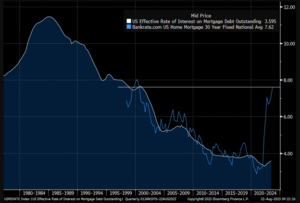Questions Investment Professionals are Asking
September 8, 2023
To Inform:
Last week, Alex Durbin and I attended the CFA (Chartered Financial Society) Society of Columbus’ Fall kick-off dinner. It was a gathering of investment professionals throughout Central Ohio representing state pension systems, large insurance companies, banks, and wealth managers. Tom Jalics, CFA, Chief Investment Strategist at Fifth Third Bank, entertained the audience with an interactive presentation with lots of questions from the audience concerning topics ranging from the housing market, the US Dollar, and of course politics and the Fed. Here is a summary of a few key topics covered that evening.
Effective Mortgage Rates Are Different from Nominal Mortgage Rates
Jalics started off talking about the economy and someone from the back of the room quickly asked, “when are higher mortgage rates going to put a damper on the economy?” A discussion then ensued about the historic difference between the “effective mortgage rate” or the average rate consumers are actually paying on their mortgage and the “nominal mortgage rate” or the rate someone would have to pay for taking out a new mortgage. With mortgage rates being so low for the last ten years, many homeowners refinanced or locked a long-term mortgage at historically low rates – in many cases, below 3%. As long as these homeowners don’t move, they can continue to enjoy the low rate they’ve locked in, even as the rate for new mortgages soars above 7%.
We found the chart below to illustrate the conclusion. According to Bloomberg data (as of late August), the effective mortgage rate (white line in chart) is about 3.6% even as the national average for a new 30-year mortgage (blue line) exceeds 7.6%. As you can see from the chart, since the late ‘90s the two lines have tended to be close together until now. The historic gap is the result of consumers locking in long-term financing and unless they move, they don’t have to “feel the pain” of higher mortgage rates. Bottom line, low effective mortgage supports a stronger consumer and also makes for continued tight supply in the housing market.

Source: Hamilton Lane, Bloomberg
Current Employment Environment Not Consistent with Recession
Of course, someone in the crowd asked the big question – “forecasters have been talking about a recession for close to two years now…is a recession coming?” Paraphrasing Jalics, “jobs drive U.S. consumer spending and consumer spending drives the U.S. economy.” The discussion focused on the tight labor market, and we found the chart below to illustrate the point.
Starting from the bottom of the chart, there are approximately 168 million people in the U.S. labor force. There are about 9 million job openings and 161 million employed. Doing the math, 161 plus 9 is greater than 168, implying there are still more job openings than people looking for work.

Source: Strategas Research Partners
Approximately 70% of the U.S. economy is driven by consumer spending. With unemployment at close to a 40-year low, people are earning wages and spending those wages which in turn drives our economy forward. The big picture conclusion was there is still the possibility of a slowdown in the next 12 months, but until we see a deterioration in the employment picture, it’s tough to see a deep recession.
The Dollar as The Reserve Currency
Another big question from the astute investment audience was “do you think the dollar is at risk of losing its world reserve currency status?” The short answer to the discussion was NO and there were two points made to back up that answer:
- The U.S. dollar accounts for approximately 90% of foreign exchange transactions globally. (We looked it up – it’s true)
- The U.S. dollar accounts for close to 60% of global foreign currency reserves (see chart below):

Source: Reuters, International Monetary Fund
The point was made that well before the dollar would be in any danger of losing its world reserve currency status, these two measures would have to weaken significantly. In other words – these two measures – the dollar’s role in global transactions and the dollar’s role in global reserves are key metrics to watch.
Next week, at our Portfolio and Points Oktoberfest event, Alex and I will have the opportunity to answer YOUR questions. In an event which has become somewhat of a Joseph Group tradition the last few years, we will be pulling questions out of a German hat and answering as many of those questions as possible. The audience won’t know what is coming, and neither will we! You can RSVP and learn how to submit your questions here. Please feel free to bring a friend and we look forward to seeing as many of you as possible at the Hofbräuhaus on Thursday, September 14!

Written by Travis Upton, Partner, CEO and Chief Investment Officer